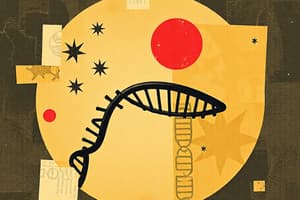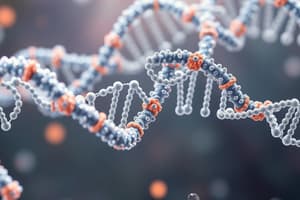Podcast
Questions and Answers
What is the main function of nucleic acids according to the text?
What is the main function of nucleic acids according to the text?
- To form the primary, secondary and tertiary structures of DNA
- To produce proteins
- To act as polymers of nucleotides
- To store and transfer information needed for cell function (correct)
Which of the following is NOT a type of nucleic acid mentioned in the text?
Which of the following is NOT a type of nucleic acid mentioned in the text?
- Peptide nucleic acid (PNA) (correct)
- Ribonucleic acid (RNA)
- Mitochondrial DNA
- Deoxyribonucleic acid (DNA)
What is the Watson-Crick model related to?
What is the Watson-Crick model related to?
- The primary structure of RNA
- The composition and structure of DNA (correct)
- The tertiary structure of proteins
- The secondary structure of DNA
What is the purpose of describing the primary, secondary and tertiary structure of DNA?
What is the purpose of describing the primary, secondary and tertiary structure of DNA?
Which type of DNA supercoiling is mentioned in the text?
Which type of DNA supercoiling is mentioned in the text?
What is the purpose of studying molecular biology according to the text?
What is the purpose of studying molecular biology according to the text?
What is the orientation of the two DNA strands?
What is the orientation of the two DNA strands?
What type of bonds hold the complementary base pairs together?
What type of bonds hold the complementary base pairs together?
How many hydrogen bonds are present between adenine and thymine?
How many hydrogen bonds are present between adenine and thymine?
Which of the following statements about the DNA sequence is correct?
Which of the following statements about the DNA sequence is correct?
What is the role of base stacking in the stability of the DNA double helix?
What is the role of base stacking in the stability of the DNA double helix?
What is the function of DNA replication in relation to the complementary base pairing?
What is the function of DNA replication in relation to the complementary base pairing?
How many base pairs or steps are there for each complete turn of the DNA helix?
How many base pairs or steps are there for each complete turn of the DNA helix?
What is the width of the B-form of DNA?
What is the width of the B-form of DNA?
Which form of DNA has major and minor grooves with widths of 2.2 nm and 1.2 nm respectively?
Which form of DNA has major and minor grooves with widths of 2.2 nm and 1.2 nm respectively?
What is a special characteristic of Z form DNA?
What is a special characteristic of Z form DNA?
Which structural form of DNA is described as thicker and shorter than the B form?
Which structural form of DNA is described as thicker and shorter than the B form?
Where is the A form of DNA found?
Where is the A form of DNA found?
What is the typical length of Z-DNA stretches found at the 5' ends of genes?
What is the typical length of Z-DNA stretches found at the 5' ends of genes?
What is the primary function of DNA supercoiling?
What is the primary function of DNA supercoiling?
Which type of supercoiling is more commonly present under normal physiological conditions?
Which type of supercoiling is more commonly present under normal physiological conditions?
Which type of supercoiling is associated with the winding of DNA around histones?
Which type of supercoiling is associated with the winding of DNA around histones?
What is the main advantage of having DNA in a negatively supercoiled form?
What is the main advantage of having DNA in a negatively supercoiled form?
What is the structure of the DNA molecule in a typical prokaryotic organism?
What is the structure of the DNA molecule in a typical prokaryotic organism?
What are the four main nucleotides that form the primary structure of DNA?
What are the four main nucleotides that form the primary structure of DNA?
How are the nucleotides linked together in a DNA strand?
How are the nucleotides linked together in a DNA strand?
What do the alternating sugar-phosphate units form in a DNA strand?
What do the alternating sugar-phosphate units form in a DNA strand?
What determines the coding structure (genetic information) of DNA?
What determines the coding structure (genetic information) of DNA?
What is the direction of writing the order of nucleotides in a DNA strand?
What is the direction of writing the order of nucleotides in a DNA strand?
What type of helix does the DNA double helix have?
What type of helix does the DNA double helix have?
Flashcards are hidden until you start studying
![Molecular Biology: Nucleic Acids Structure [BIO 206]](https://images.unsplash.com/photo-1523112784166-c04db3a3bb7c?crop=entropy&cs=srgb&fm=jpg&ixid=M3w0MjA4MDF8MHwxfHNlYXJjaHw1fHxNb2xlY3VsYXIlMjBCaW9sb2d5JTJDJTIwTnVjbGVpYyUyMEFjaWRzJTJDJTIwRE5BJTIwc3RydWN0dXJlJTJDJTIwQmlvY2hlbWlzdHJ5fGVufDF8MHx8fDE3MTIwMzEyNDR8MA&ixlib=rb-4.0.3&q=85&w=800&fit=crop&h=300&q=75&fm=webp)
![Molecular Biology: Nucleic Acids Structure [BIO 206]](https://images.unsplash.com/photo-1575468130766-fce03f7afaab?crop=entropy&cs=srgb&fm=jpg&ixid=M3w0MjA4MDF8MHwxfHNlYXJjaHwxMnx8TW9sZWN1bGFyJTIwQmlvbG9neSUyMENlbGwlMjBCaW9sb2d5JTIwTnVjbGVpYyUyMEFjaWRzJTIwQmlvc2NpZW5jZXN8ZW58MXwwfHx8MTcwMzkyNTEyNHww&ixlib=rb-4.0.3&q=85&w=300&fit=crop&h=200&q=75&fm=webp)


